-
Read about the amazing Ramappa group of
temples-masterpieces of Indian sculptural art.
The temple is a place of beauty, it is a place of revelation, it is a
place of peace. It is the house of the Lord.” ― Howard W. Hunter
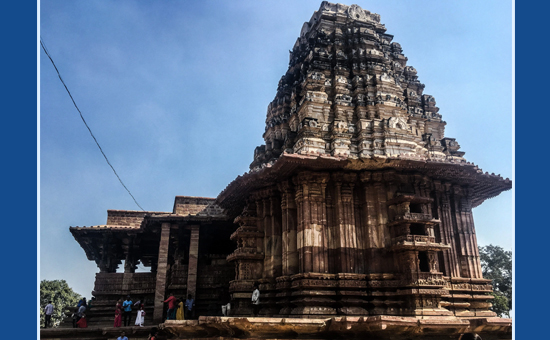
The Palampet temples
In a serene valley of the long forgotten village of
Palampet, amidst vast crop fields, surrounded by wooded hills and a large lake,
stands the jewel in the crown of Kakatiyan architecture, the Ramappa group of
temples. These temples are filled with sculptures that can easily be
counted among the masterpieces of Indian sculptural art, and they create a
perfect balance between the two ancient art forms prevalent in India: architecture
and sculpture.
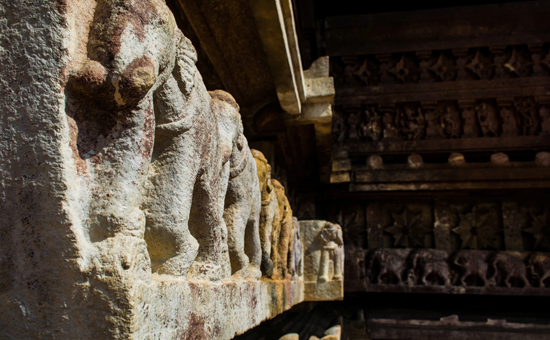
When we arrived here on a warm Sunday
afternoon, there was nothing to show the past importance of the now tiny,
remote village of Palampet. With green fields stretching as far as the horizon
and wooded slopes casting dark shadows, there was an air of peace and
tranquillity, as we drove towards the temple following the dusty roads that led
to it.
A brief look at history
The Ramappa group of temples were built in 1213 CE,
around a huge man-made lake/tank that was built as a water resource to help
primarily in irrigation.
Situated in the village of Palampet, the temple
complex was built by Recharla Rudra,
the chief of army during the rule of Ganapatideva.
The complex is named after the main architect Ramappa Stapathi, and is among the few temples that honour the
person who designed it. According to an inscription on a slab in a mandapa, the
temples were built as a “as part of the Saptasantaras.”
The entire temple complex has the Rudreswara temple
(dedicated to Shiva) as the main temple, a Nandi mandapa, subsidiary
temples (Kateswara and Kameswara) seen at the north and south sides of the
Rudreswara temple, an inscription pillar, and a dharamsala. Surrounding
these structures is the prakara that runs round the entire complex.
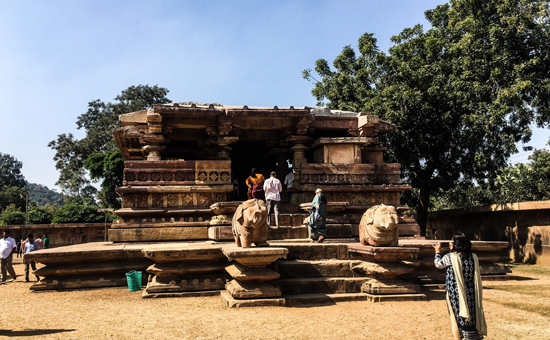 The Kateshwar Temple.
The Kateshwar Temple.
During the ‘Kakatiyan’
era the temples were not only important places of worship, but these were also
seen as “landholder, employer and consumer of goods and services, as bank,
school and museum, as hospital and theatre, in short, as a nucleus which
gathered around itself all that was best in the arts of
civilised existence and regulated them with the humanness born of the
spirit of dharma, the medieval Indian temple has few parallels in the annals of mankind.” (as P.S. Kanaka Durga wrote
in, State and society under the Kakatiyas of Warangal: A critical
Appraisal (A.D. 1000- 1323)). For more on Kakatiyan temples click on this
Within the temple complex, the Rameswara temple is
the only structure that remains relatively undamaged, while the Kateswara
temple and the nandi mandap are partly damaged, and the Kameswara temple is
completely in ruins. There are ruins of other smaller temples around the lake,
but those are unsafe to approach, as the stones look ready to tumble down any
moment.
As we entered the surviving temples, the intricacy
of the sculptures and carvings on the stone panels took our breath away. The
13th century figures carved on stones looked alive, and one almost expects them
to breathe and start moving. Frozen for posterity, each
of these sculptures had a tale to tell of its own, as they looked down
on us with their serene faces and eyes.
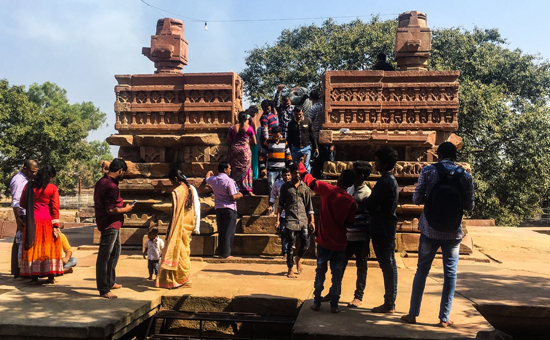 Crowds throng the partially destroyed nandi mandapa.
Crowds throng the partially destroyed nandi mandapa.
Crowds
throng temple. The Ramappa group of temples is a functional site, and large
crowds paying obeisance to the nandi and Shiva are a common sight here.
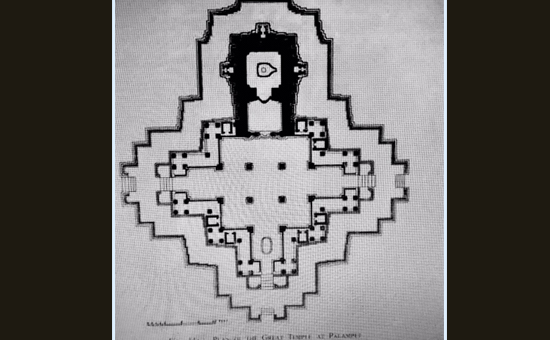
The temple plan of the
main Rameswara temple. A flight of five steps lead to the stepped diamond basement
that forms the entrance of the mandapa, and another flight of steps takes one
into the mandapa from three sides, as seen in the plan here. Photo
source: The ASI archives.
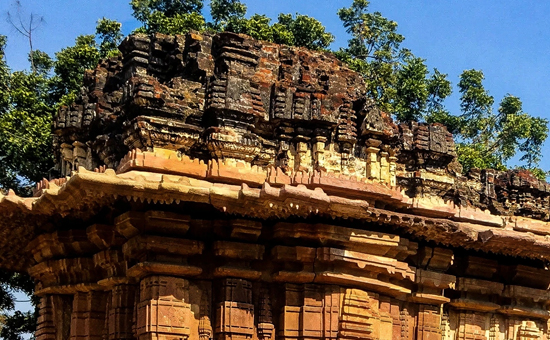
The Ramappa temples,
which are of the prefabricated type, is built of red and white tinged sandstone
and show beautiful brick shikharas and ardhashikharas in
front, keeping in line with the Chalukyan pattern. The special feature of
these temples is the use of feather lite spongy bricks that float on water, a man made technological ingenuity of the
13th century.
Another innovation seen
in these temples is the use of sand-box technology,
where the foundation pit was topped with sand that would act as a support or
cushion during earthquakes, thus protecting the structures.
The garbagriha of the
Kateswara temple is a trikuta, commonly seen in many Kakatiyan
temples, a style that was earlier developed by the Chalukyans.
The 12 bracket figures
of the madanikas in the Rameswara temple bring out the best in the
Kakatiyan sculptural art, reflecting the skilled artistry of that period that could
use chisels on black basalt and carve out exquisite figures in graceful
rhythmic poses. These slim, tall, and graceful madanikas along with other
female figures inside the temple in varying dance poses became the inspiration
for a dance treatise known as Nrityaratnavali that was written
by Jayasenapati, a Kakatiyan army general.
The Rameswara temple
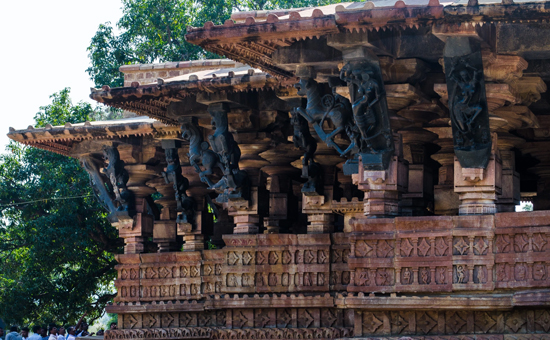 The outside walls.
The outside walls.
An important difference of the Kakatiyan temples from the Hoysalas is
seen in the space that we notice between the mandapa parapet walls and the
roof, which allows air and light to come in and doesn’t make the visitor feel
claustrophobic. Though like the Hoysalas, the temple plan here is stepped
diamond, with three storied niches on three sides of the temple walls, and the topmost
band of the base on the stellate platform also shows a frieze of elephants that
runs all around the temple (for more on elephants and other such small
sculptures on Kakatiyan temples click here
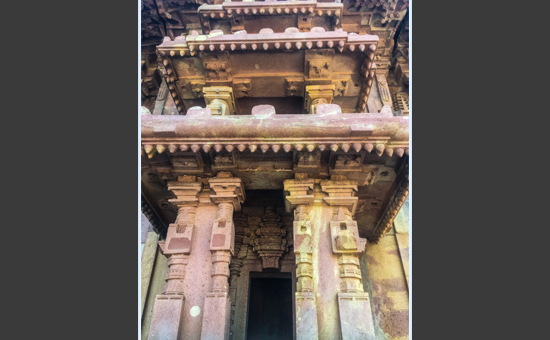 Three storied niches on the three sides of the temple walls.
Three storied niches on the three sides of the temple walls.
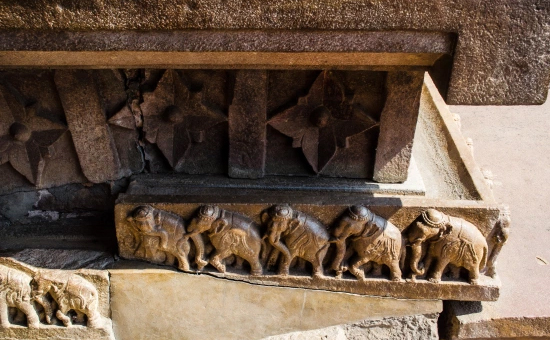
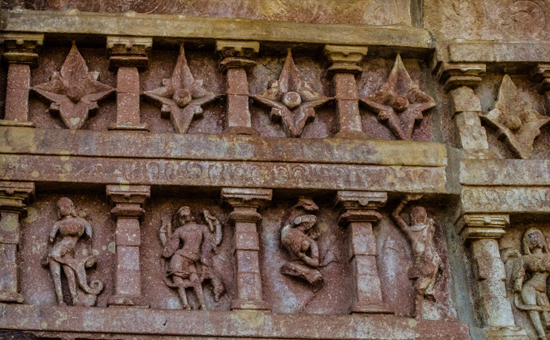
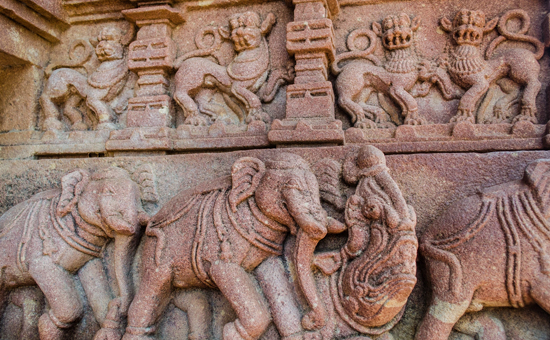
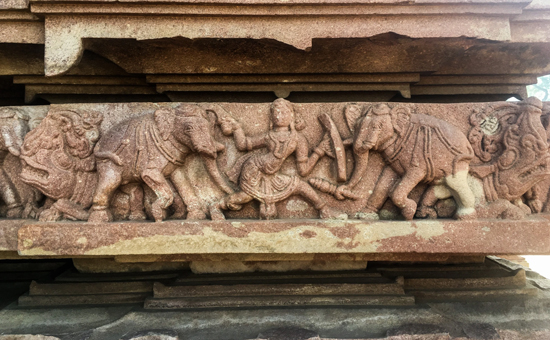
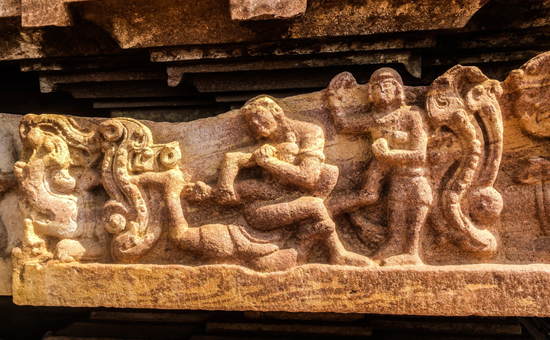
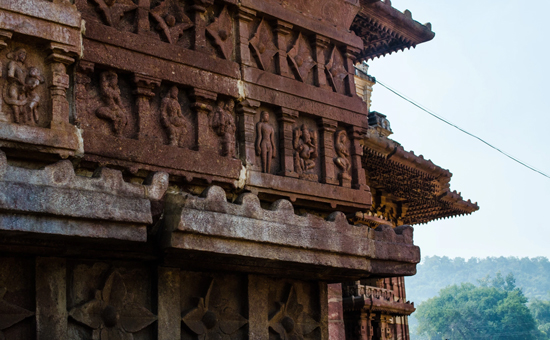
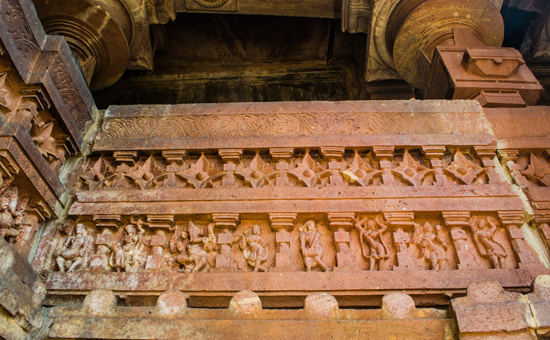
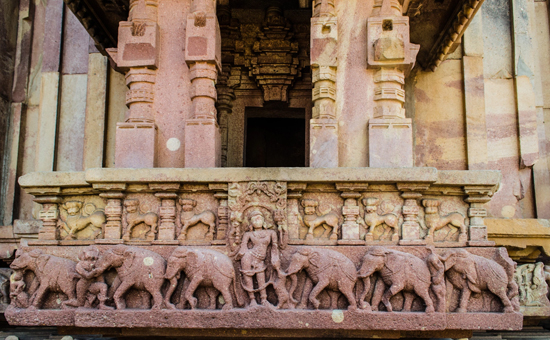
The temple wall friezes show four
petalled flowers, half-moons on outer edges, single figures lined between two
pillars, elephants, lions, etc. The single figures show females doing their hair, donning a saree, applying vermilion
on foreheads, huntresses, chawrie bearers, drummers, mithuna couples, Saivite
devotees, Bhairava, Surya, dancing Ganesh, Narasimha, soldiers with shields,
and standing Jain tirthankaras.
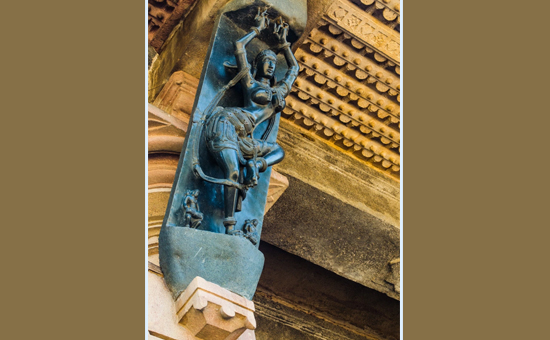
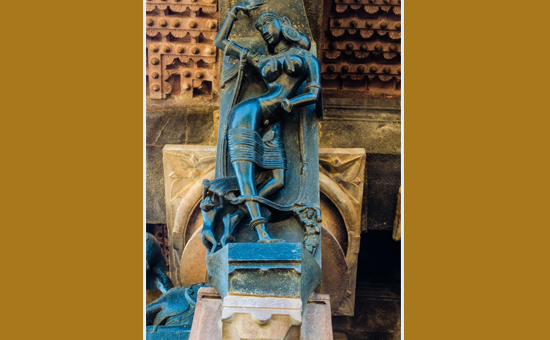
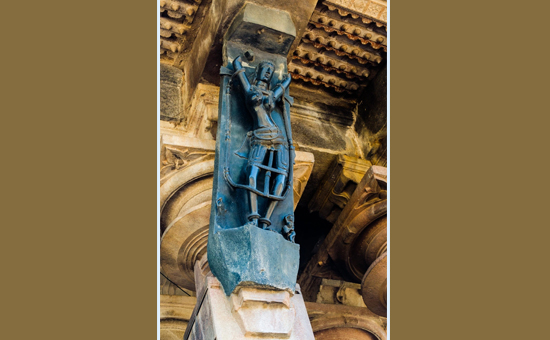
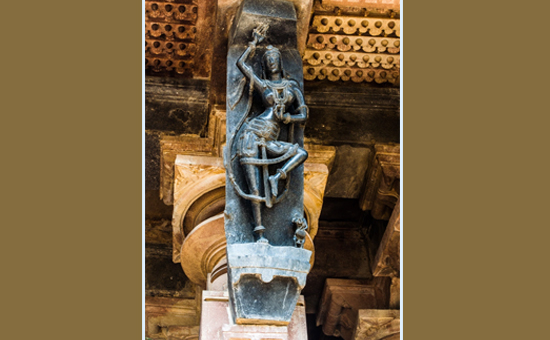
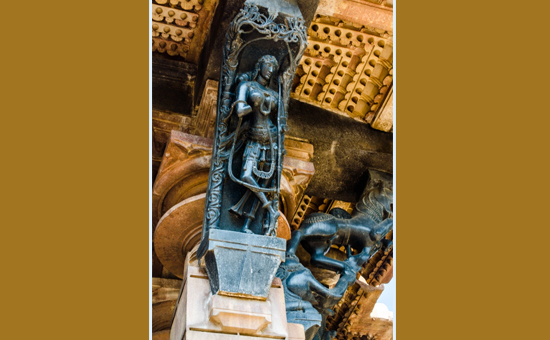
The madanikas or salabhanjikas of the
Rameswara temple form an important part of this temple, and one cannot miss
these tall, lithe, black bracket figures on pillars, two on each side of the
entrances.
Unlike the voluptous Hoyala madanikas
and the typical beauties of the classical Indian art, these madanikas/salabhanjikas
exhibit slim and tall figures in graceful poses; however their faces that have
noticeably large eyes, are rather wooden with no emotions. Not all madanikas
are dancers; one is a nagini, one is
a huntress with a bow and arrow, one is a drummer, and two are
jaganmohinis. Besides the salabhanjikas/madanikas, there are gajasimhas on basalt brackets all around
the mandapa that form the royal insignia of the Kakatiyas.
Inside the temple
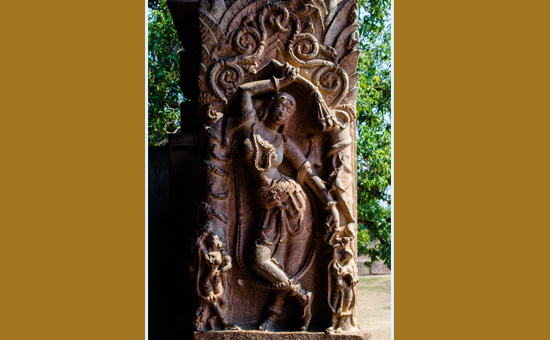 On the 2 sides of the 3 mandapa entrances there are women figures in
different postures; a huntress, a salabhanjika, among others.
On the 2 sides of the 3 mandapa entrances there are women figures in
different postures; a huntress, a salabhanjika, among others.
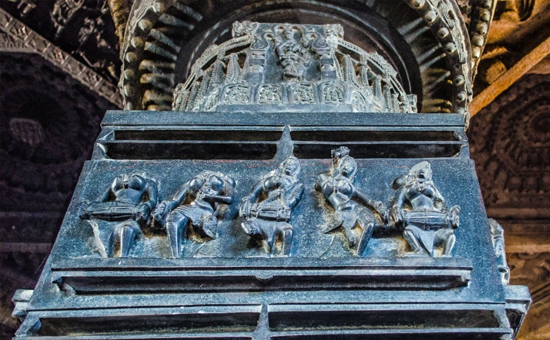
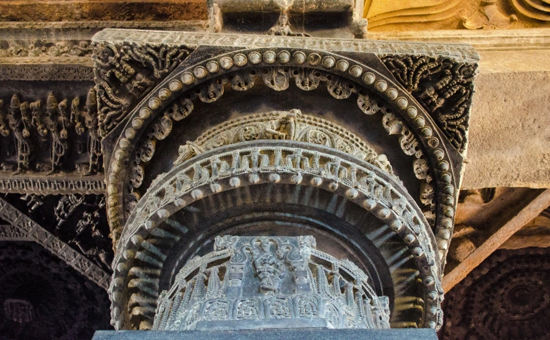
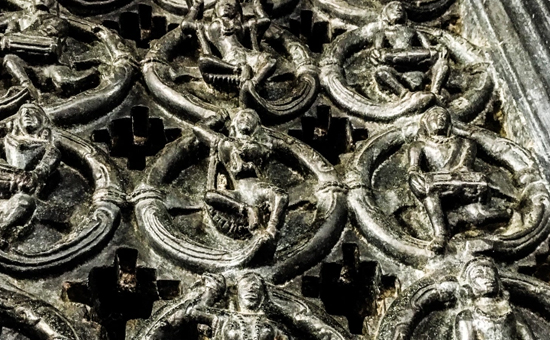 Jaali work on the entrance door to the antarala has
circles that are formed by creepers encircling dancers and drummers.
Jaali work on the entrance door to the antarala has
circles that are formed by creepers encircling dancers and drummers.
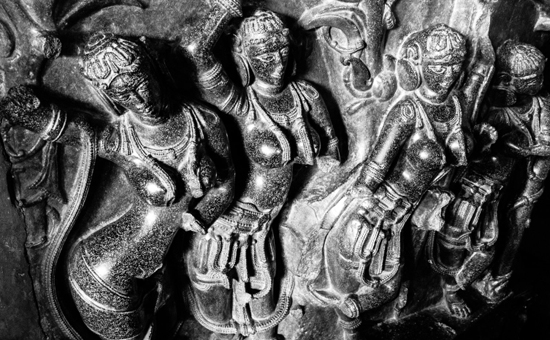 Women in a palm grove, seen at the lower part of the door jamb.
Women in a palm grove, seen at the lower part of the door jamb.
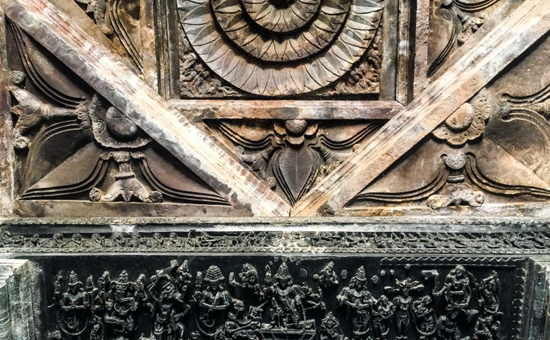
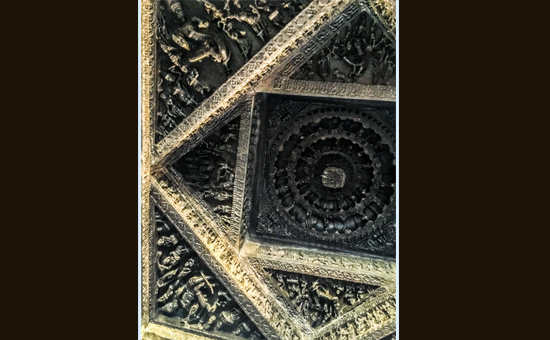
The rangamandapa
inside is a circular, raised, single black stone, and has exquisitely carved
pillars on four sides with intricately sculpted roof that speaks of various
stories, where we see a king standing with a sword while women holding parrots
surround him. The different sculptures on pillars and ceilings shows the
astadikpalas, and also tell tales of the samudramanthana
(the Devas are seen with halos while the asuras do not show any), Shiva’s
marriage, the killing of Gajasura, Krishna’s vastraharana, and many other tales from the epics.
The Kateswara temple
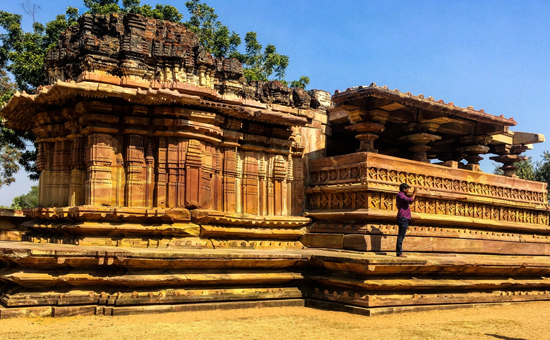
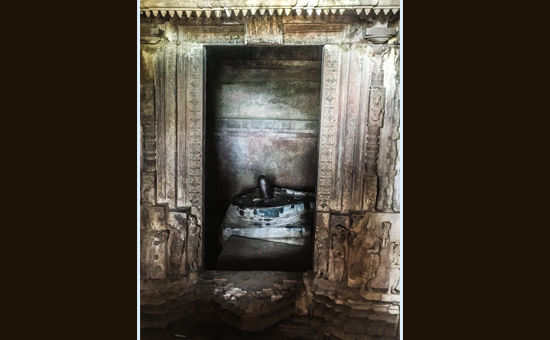
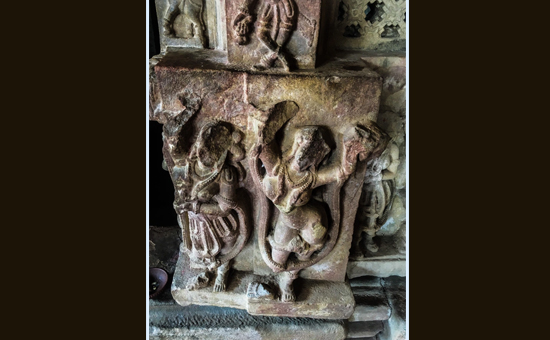
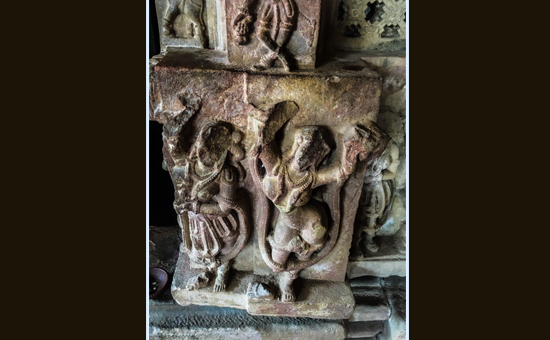
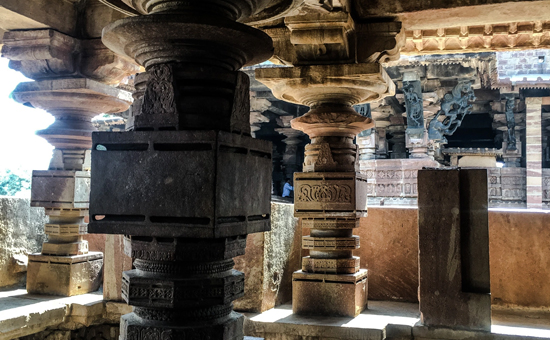
This temple is situated at the north
side of the Rameswara temple, and is also constructed with the same reddish
white sandstone, has a brick shikhara, with sculptures of dancers in different
poses on the pillars and on the door jamb.
From their free poses and limb
rhythms it can be conjectured that perhaps nritta was more popular an art with
the people of that period, than the pure classical nritya.
Joy resonates from these frozen
figures, and the visitor, as he or she moves around, absorbs this feeling of
joy and starts pulsating with the happiness emanating from these 900 years old
stone sculptures.
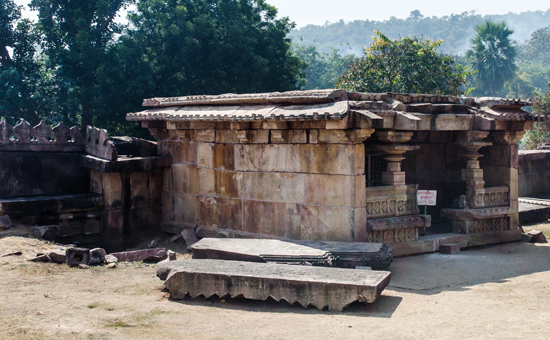 The completely destroyed remains of Kameswara temple.
The completely destroyed remains of Kameswara temple.
The
completely destroyed remains of Kameswara temple on the southern side of the
Rameswara temple. Conservation is going on and attempts are being made to
rebuild the mandapa from whatever parts are left; hence closed for public
viewing.
The dancers that we see
in many of the Kakatiyan temples reflect an art that was perhaps once seen by
the devotees sitting at leisure around the nrityamandapa, and certainly
does not comply with classical dance poses mentioned in our discourses. Each
movement that we see here is an expression of pure joy, and their varied
rhythms show a disposition to enjoy life to the full.
The Kakatiyan era was synonymous with wealth and prosperity
of the common people, large-scale developments that included turning forest
tracts into fertile farmlands with the help of innumerable large man-made
tanks, and prosperous overseas trading with many foreign countries.
Thus, the lives of
common people were filled with joy and contentment, and it is this feeling that
we see reflecting in the sculptures. Almost 1000 years later, when
we now see these temple sculptures, we witness a historical
documentation, an actual glimpse into a society and its people whose lives once
resonated with happiness and prosperity.
How to reach: Palampet is around 77 km from Warangal, and 157 km from Hyderabad, in the state of Telengana. The best way to reach this village is by a car, though there are other local conveyances available too.
Time to visit: December and January are comparatively cooler months, hence the only time to visit for tourists, travellers, and heritage enthusiasts.
To read all articles
by author
Author studies life sciences, geography, art and international relationships. She loves exploring and documenting Indic Heritage. Being a student of history she likes to study the iconography behind various temple sculptures. She is a well-known columnist - history and travel writer. Or read here
Article
was first published on author’s blog and here
Article and pictures are courtesy and copyright author.